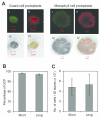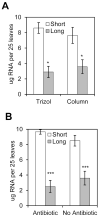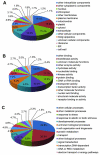Guard cell purification and RNA isolation suitable for high-throughput transcriptional analysis of cell-type responses to biotic stresses
- PMID: 23634837
- PMCID: PMC3982617
- DOI: 10.1094/MPMI-03-13-0081-TA
Guard cell purification and RNA isolation suitable for high-throughput transcriptional analysis of cell-type responses to biotic stresses
Abstract
Stomata, micro-pores on the leaf surface, are formed by a pair of guard cells. In addition to controlling water loss and gas exchange between the plant and the environment, these cells act as immunity gates to prevent pathogen invasion of the plant apoplast. Here, we report a brief procedure to obtain highly pure guard cell preparations using conditions that preserve the guard cell transcriptome as much as possible for a robust high-throughput RNA sequence analysis. The advantages of this procedure included i) substantial shortening of the time required for obtaining high yield of >97% pure guard cell protoplasts (GCP), ii) extraction of enough high quality RNA for direct sequencing, and iii) limited RNA decay during sample manipulation. Gene expression analysis by reverse transcription quantitative polymerase chain reaction revealed that wound-related genes were not induced during release of guard cells from leaves. To validate our approach, we performed a high-throughput deep-sequencing of guard cell transcriptome (RNA-seq). A total of 18,994 nuclear-encoded transcripts were detected, which expanded the transcriptome by 70%. The optimized GCP isolation and RNA extraction protocols are simple, reproducible, and fast, allowing the discovery of genes and regulatory networks inherent to the guard cells under various stresses.
Figures





Similar articles
-
A comparative study of the Arabidopsis thaliana guard-cell transcriptome and its modulation by sucrose.PLoS One. 2012;7(11):e49641. doi: 10.1371/journal.pone.0049641. Epub 2012 Nov 21. PLoS One. 2012. PMID: 23185391 Free PMC article.
-
Common and unique elements of the ABA-regulated transcriptome of Arabidopsis guard cells.BMC Genomics. 2011 May 9;12:216. doi: 10.1186/1471-2164-12-216. BMC Genomics. 2011. PMID: 21554708 Free PMC article.
-
Preparation and applications of Arabidopsis thaliana guard cell protoplasts.New Phytol. 2002 Mar;153(3):517-526. doi: 10.1046/j.0028-646X.2001.00329.x. Epub 2002 Mar 5. New Phytol. 2002. PMID: 33863229
-
Gate control: guard cell regulation by microbial stress.New Phytol. 2014 Sep;203(4):1049-1063. doi: 10.1111/nph.12916. Epub 2014 Jul 8. New Phytol. 2014. PMID: 25040778 Review.
-
Take a deep breath: peptide signalling in stomatal patterning and differentiation.J Exp Bot. 2013 Dec;64(17):5243-51. doi: 10.1093/jxb/ert246. Epub 2013 Aug 30. J Exp Bot. 2013. PMID: 23997204 Review.
Cited by
-
Sugarcane Genotypes with Contrasting Biological Nitrogen Fixation Efficiencies Differentially Modulate Nitrogen Metabolism, Auxin Signaling, and Microorganism Perception Pathways.Plants (Basel). 2022 Jul 29;11(15):1971. doi: 10.3390/plants11151971. Plants (Basel). 2022. PMID: 35956449 Free PMC article.
-
Spatial and temporal regulation of biosynthesis of the plant immune signal salicylic acid.Proc Natl Acad Sci U S A. 2015 Jul 28;112(30):9166-73. doi: 10.1073/pnas.1511182112. Epub 2015 Jul 2. Proc Natl Acad Sci U S A. 2015. PMID: 26139525 Free PMC article.
-
Regulation of Stomatal Defense by Air Relative Humidity.Plant Physiol. 2016 Nov;172(3):2021-2032. doi: 10.1104/pp.16.00696. Epub 2016 Oct 4. Plant Physiol. 2016. PMID: 27702841 Free PMC article.
-
Novel Role of JAC1 in Influencing Photosynthesis, Stomatal Conductance, and Photooxidative Stress Signalling Pathway in Arabidopsis thaliana.Front Plant Sci. 2020 Jul 29;11:1124. doi: 10.3389/fpls.2020.01124. eCollection 2020. Front Plant Sci. 2020. PMID: 32849690 Free PMC article.
-
GENERAL CONTROL NONREPRESSIBLE4 Degrades 14-3-3 and the RIN4 Complex to Regulate Stomatal Aperture with Implications on Nonhost Disease Resistance and Drought Tolerance.Plant Cell. 2017 Sep;29(9):2233-2248. doi: 10.1105/tpc.17.00070. Epub 2017 Aug 30. Plant Cell. 2017. PMID: 28855332 Free PMC article.
References
-
- Chitrakar R, Melotto M. Assessing stomatal response to live bacterial cells using whole leaf imaging. J. Vis. Exp. 2010:44. http://www.jove.com/index/details.stp?id=2185, doi: 10.3791/2185. - PMC - PubMed
Publication types
MeSH terms
Substances
Grants and funding
LinkOut - more resources
Full Text Sources
Other Literature Sources
Molecular Biology Databases

